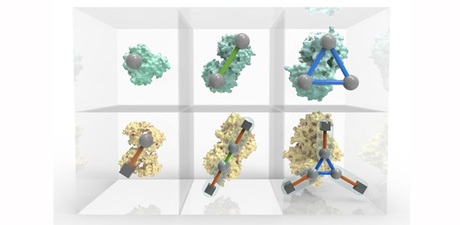The periodic table of protein complexes

UK researchers have published The Periodic Table of Protein Complexes — a valuable tool for research into evolution and protein engineering. Created by a team led by the Wellcome Trust Campus and the University of Cambridge, the table offers a way of looking at the variety of structures that proteins can build in nature, anticipating which ones might be discovered next and predicting how entirely novel structures could be engineered.
Almost every biological process depends on proteins interacting and assembling into complexes in a specific way, and many diseases are associated with problems in complex assembly. The principles underpinning this organisation are not yet fully understood, but by defining the fundamental steps in the evolution of protein complexes, the new 'periodic table' presents a systematic, ordered view on protein assembly, providing a visual tool for understanding biological function.
“Evolution has given rise to a huge variety of protein complexes, and it can seem a bit chaotic," said Joe Marsh, formerly of the Wellcome Genome Campus and now of the MRC Human Genetics Unit at the University of Edinburgh. “But if you break down the steps proteins take to become complexes, there are some basic rules that can explain almost all of the assemblies people have observed so far."
Protein complex assembly can be seen as endless variations on dimerisation (one doubles and becomes two), cyclisation (one forms a ring of three or more) and subunit addition (two different proteins bind to each other). Because these happen in a fairly predictable way, it's not that hard to anticipate how a novel protein would form.
“We're bringing a lot of order into the messy world of protein complexes," said Sebastian Ahnert of the Cavendish Laboratory at the University of Cambridge. “Proteins can keep go through several iterations of these simple steps, adding more and more levels of complexity and resulting in a huge variety of structures. What we've made is a classification based on these underlying principles that helps people get a handle on the complexity.
“By analysing the tens of thousands of protein complexes for which three-dimensional structures have already been experimentally determined, we could see repeating patterns in the assembly transitions that occur — and with new data from mass spectrometry, we could start to see the bigger picture," added Marsh.
The table has been published in the journal Science, with an interactive version available online at http://www.periodicproteincomplexes.org/.
COVID-19 infection increases risk of heart attack and stroke
COVID-19 infection may increase the risk of heart attack, stroke and death from any cause for up...
A bout of COVID could protect you from a severe case of flu
Recovery from COVID appears to have a protective effect against the worst effects of the flu,...
Vaping bad for brain health; residue may affect unborn babies
University students who vape appear to have lower cognitive function scores, while exposure to...




